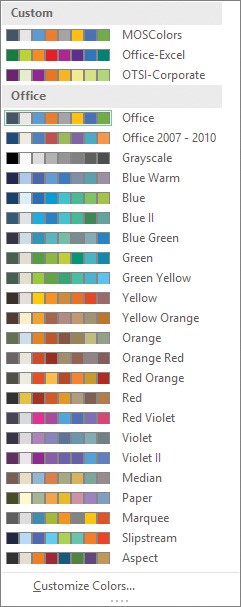Objective 2.3: Create and Modify Custom Workbook Elements (δείγμα)
- 2.3.1. Create and modify cell styles
- 2.3.2. Create custom themes and theme elements
- 2.3.3. Create and modify simple macros
- 2.3.4. Insert and configure form controls
OBJECTIVE 2.3: Contents
2.3.2. Create custom themes and theme elements
Create and modify custom themes
A workbook theme is a predefined collection of color, font, and effect formatting options. Each theme comes with preset formatting in three categories: color scheme, font set, and effects (which includes formatting such as drop shadows and 3D effects). Excel offers more than three dozen predefined themes.
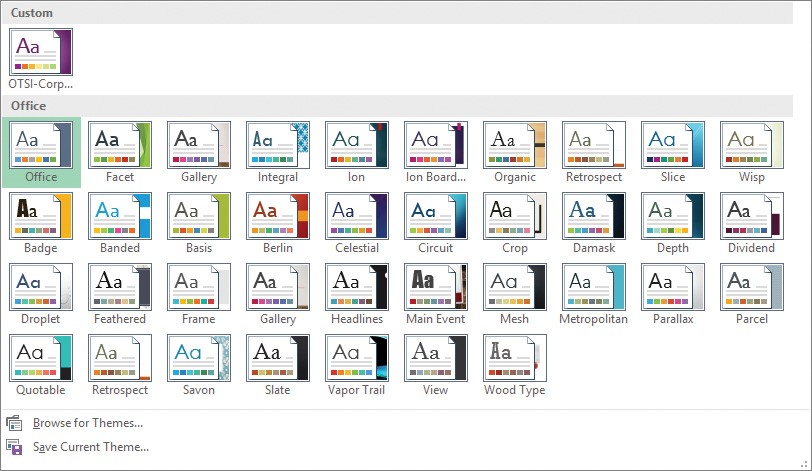
Custom themes appear at the top of the Themes menu, above the 37 built-in themes in the Office gallery
If none of the predefined themes offer the exact formatting you require, you can modify any theme by selecting a different color scheme, font set, or effects scheme. You can even create your own custom color and font sets. However, if you go to all this trouble to get your workbook formatting just right, it is time-consuming to have to repeat the same steps for other workbooks you open or create. To avoid this problem, you can save your theme customizations as a new workbook theme. This enables you to apply the custom formatting to any workbook just by selecting the custom theme.
- Exam Strategy: The objective domain for Exam 77-728, “Excel Expert 2016: Interpreting Data for Insights,” requires you to demonstrate the ability to create custom color schemes, font sets, and themes. You will not be required to customize effect schemes.
Create custom color schemes
Excel offers many tools for turning a plain, unformatted worksheet into an attractive, professional-quality model. For example, features such as custom numeric and date formats and conditional formatting can make your data easier to read and analyze. The final touch involves adding just the right amount of color to your worksheets. With colors, you can emphasize important results, shape the layout of your page, and add subtle psychological effects. Excel comes with nearly two dozen built-in color schemes that make it easy to apply colors to your worksheets.
|
Custom color schemes appear at the top of the Theme Colors menu, above the 23 built-in color schemes in the Office gallery |
However, if no scheme offers the exact colors you want, you can create your own. Each scheme consists of 12 color elements:
To create a custom color scheme, you can replace any of the dozen theme colors with an existing theme color, a standard color, or a custom color |
For each element, you can choose a color from the standard color palette, or you can create a custom color. Excel offers two color models:
![]() RGB This color model is based on the idea that you can create any color by combining three base colors: red, green, and blue. You assign a value between 0 and 255 for each color: the higher the number, the more intense the color.
RGB This color model is based on the idea that you can create any color by combining three base colors: red, green, and blue. You assign a value between 0 and 255 for each color: the higher the number, the more intense the color.
- Tip: In the RGB color model, when the red, green, and blue values are equal, you get a gray-scale color. Lower numbers produce darker grays, and higher numbers produce lighter grays. Black has RGB values of 0, 0, 0 and white has RGB values of 255, 255, 255.
 HSL This color model is based on three properties, each of which is assigned a value between 0 and 255:
HSL This color model is based on three properties, each of which is assigned a value between 0 and 255:
• Hue (which is more or less equivalent to the term color) measures the position on the color spectrum. Lower numbers indicate a position near the red end, and higher numbers move through the yellow, green, blue, and violet parts of the spectrum.
• Saturation is a measure of the purity of a particular hue, with 255 giving a pure color, and lower numbers indicating that more gray is mixed with the hue until, at 0, the color becomes part of the gray scale.
• Luminance is a measure of the brightness of a color, where lower numbers are darker, and higher numbers are brighter.
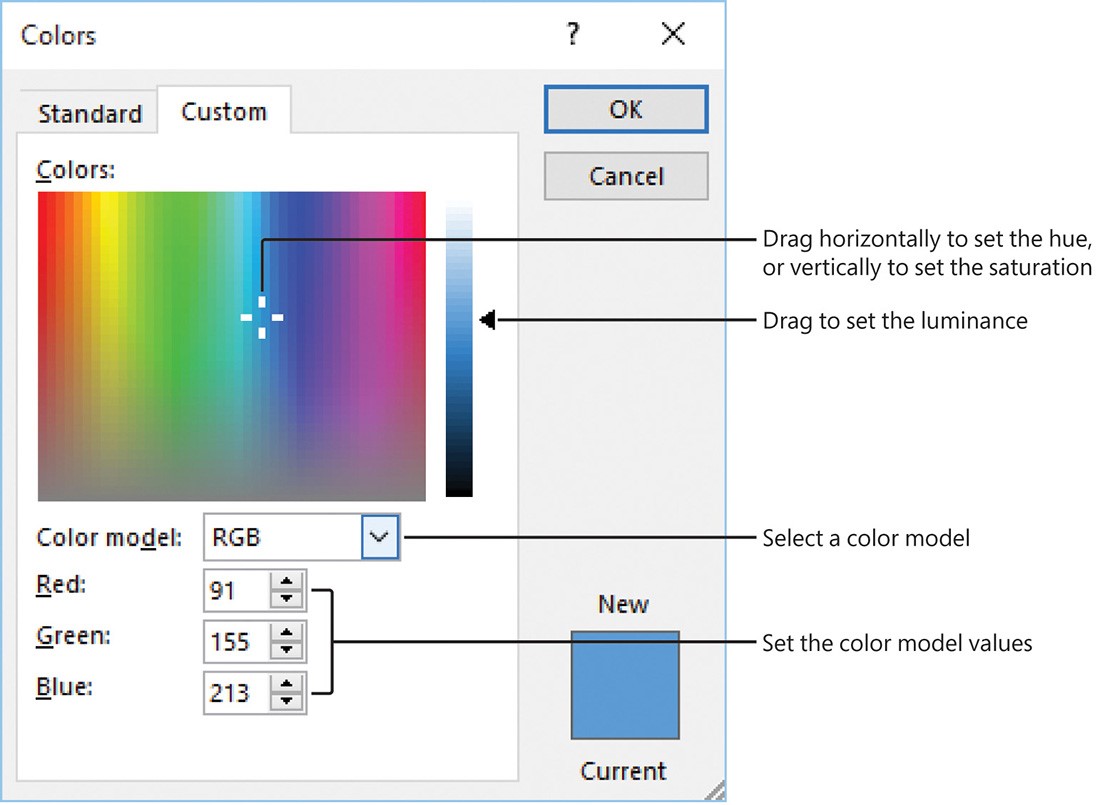
On the Custom tab, you can either specify RGB or HSL values, or you can drag the color pointer and the luminance slider
Create custom font sets
Each Excel theme comes with more than two dozen built-in font sets that make it easy to apply fonts to your worksheets. Each font set defines two fonts: a +Heading font that Excel uses for title and heading text; and a +Body font that Excel uses for regular worksheet text. The typeface is often the same for both types of text, but some font sets use two different typefaces, such as Cambria for titles and headings and Calibri for body text. If no existing font set includes the typefaces you want, you can create your own.
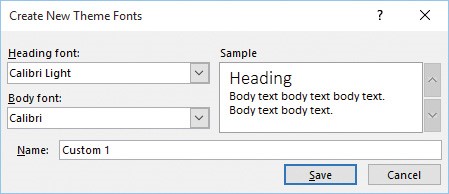
A custom font set can include any installed fonts
To create a custom color scheme
1. On the Page Layout tab, in the Themes group, click Colors, and then click Customize Colors to open the Create New Theme Colors dialog box.
- Tip: If an existing color scheme is close to what you want, you can save some time and effort by using that color scheme as your starting point. On the Page Layout tab, in the Themes groups, click Colors, and then click the color scheme to apply it to the workbook and use it as the starting point.
2. For any theme color you want to modify, click the color picker to display a menu of color options, and then do one of the following:
• In the Theme Colors gallery, click one of the 12 existing theme colors or 60 variations to assign it to the color role.
• In the Standard Colors gallery, click one of the 10 standard colors.
• Click More Colors to open the Colors dialog box. On the Custom tab, in the Color model list, select either RGB or HSL, do any of the following, and then click OK:
• If you chose RGB, enter specific values for Red, Green, and Blue.
• If you chose HSL, enter specific values for Hue, Sat, and Lum.
• To adjust the hue visually, drag the color pointer horizontally.
• To adjust the saturation visually, drag the color pointer vertically.
• To adjust the luminance visually, drag the luminance slider.
3. Repeat step 2 for each theme color you want to modify.
4. In the Name box, enter a name for your new color scheme.
5. Click Save to save the color scheme and apply it to the worksheet.
To create a custom font set
1. On the Page Layout tab, in the Themes group, click Fonts, and then click Customize Fonts to open the Create New Theme Fonts dialog box.
2. In the Heading font list, select a font for worksheet headings.
3. In the Body font list, select a font for worksheet text.
4. In the Name box, enter a name for your new font set.
5. Click Save to save the font set and close the dialog box.
To create a custom workbook theme
1. Create a custom color scheme.
2. Create a custom font set.
3. On the Page Layout tab, in the Themes group, click Themes, and then click Save Current Theme to open the Save Current Theme dialog box.
- Important: By default, Excel displays the Document Themes folder, which is located in your user profile’s AppData\Roaming\Microsoft\Templates folder. Save your theme in this folder to ensure that it gets displayed in the Themes list.
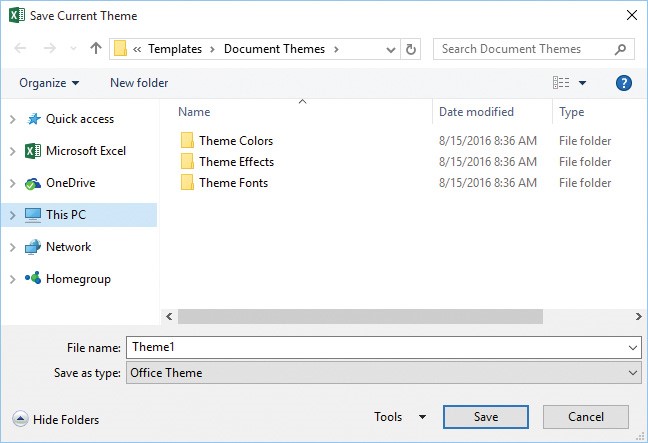
When saving your custom theme, be sure to store it in the Document Themes folder
4. In the File name box, enter a name for the custom theme.
5. Click Save.
6. To modify the theme, repeat steps 1 through 3.
